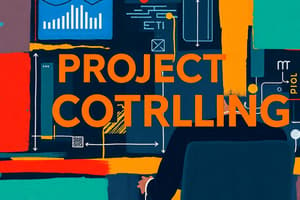Podcast
Questions and Answers
Which attribute signifies that a project is not ongoing indefinitely?
Which attribute signifies that a project is not ongoing indefinitely?
- It is temporary (correct)
- It requires resources from various areas
- It has a unique purpose
- It involves uncertainty
What is a significant advantage of using formal project management?
What is a significant advantage of using formal project management?
- Improved customer relations (correct)
- Higher complexity in coordination
- Reduced workforce engagement
- Increased project duration
Which of the following best describes the term 'progressive elaboration' in project management?
Which of the following best describes the term 'progressive elaboration' in project management?
- Defining project objectives at the end
- Initial broad definitions become clearer over time (correct)
- Eliminating all uncertainty before starting
- Creating a detailed plan from the start
Which technology was identified as a top strategic technology for 2018 according to Gartner?
Which technology was identified as a top strategic technology for 2018 according to Gartner?
What role does a project sponsor primarily fulfill in a project?
What role does a project sponsor primarily fulfill in a project?
As of 2017, how many individuals were projected to be needed in project management-oriented roles by 2027?
As of 2017, how many individuals were projected to be needed in project management-oriented roles by 2027?
Which of the following is NOT listed as a benefit of project management?
Which of the following is NOT listed as a benefit of project management?
Which of the following is an essential component discussed in project management frameworks?
Which of the following is an essential component discussed in project management frameworks?
What characterizes a well-defined objective in a project?
What characterizes a well-defined objective in a project?
What type of projects can often benefit from better project management practices?
What type of projects can often benefit from better project management practices?
What is the primary goal of stakeholder communication in project management?
What is the primary goal of stakeholder communication in project management?
Which step is NOT part of the risk management process?
Which step is NOT part of the risk management process?
What does the SMART acronym in project objectives stand for?
What does the SMART acronym in project objectives stand for?
In Agile methodologies, what is the purpose of iterative development?
In Agile methodologies, what is the purpose of iterative development?
Which of the following is a focus area in project evaluation?
Which of the following is a focus area in project evaluation?
Which component is crucial to a communication plan within stakeholder management?
Which component is crucial to a communication plan within stakeholder management?
What technique is primarily used during the risk identification step?
What technique is primarily used during the risk identification step?
Which framework is NOT considered a popular Agile methodology?
Which framework is NOT considered a popular Agile methodology?
What is the purpose of regular updates in a project's reporting process?
What is the purpose of regular updates in a project's reporting process?
What is a key benefit of using Agile methodologies compared to traditional methods?
What is a key benefit of using Agile methodologies compared to traditional methods?
Study Notes
Project Characteristics
- Projects have a unique purpose, defined by their well-defined objectives aimed at delivering specific products or services.
- Each project is temporary, having a set beginning and end.
- Projects drive change and create value, contributing positively to existing business operations.
- They are developed through progressive elaboration, starting broadly and becoming more detailed as the project advances.
- Resources are essential for project execution, often sourced from various domains including hardware, software, and personnel.
- Projects must have a primary sponsor or customer, who provides direction and funding.
- Involves inherent uncertainty, necessitating skilled project management.
Strategic Technologies for 2018
- Key technologies identified include:
- Artificial Intelligence (AI) Foundation
- Intelligent Things
- Cloud to the Edge
- Immersive Experience
Advantages of Formal Project Management
- Enhanced control over financial, physical, and human resources ensures projects run smoothly.
- Improved customer relations through structured project management practices.
- Reduction in development times leads to faster project completion.
- Cost savings and enhanced productivity are achieved through efficient resource management.
- Formal project management results in higher quality outcomes and increased reliability.
- Greater profit margins due to effective oversight and execution.
- Enhanced internal coordination fosters teamwork and communication.
- Positive effects on strategic goal achievement bolster organizational objectives.
- Improved worker morale due to clear responsibilities and successful project outcomes.
Growing Need for Project Management
- Rising interest in project management globally, particularly within IT sectors.
- Worldwide IT spending reached $3.5 trillion in 2017, marking a 2.4% increase from the previous year.
- By 2017, the Project Management Institute indicated approximately 66 million jobs in project management.
- Projection for 2027 estimates a need for 87.7 million project-oriented roles across various industries.
Project Management Framework
- Project management is defined by its structured approach to organizing and executing projects.
- Key elements include:
- Project Stakeholders: Individuals or groups affected by or involved in the project.
- Project Management Knowledge Areas: Various domains of expertise necessary for successful project delivery.
- Common Tools and Techniques: Instruments and methods used for planning, executing, and monitoring projects.
- Project Success: Criteria used to evaluate whether a project meets its intended goals and objectives.
Stakeholder Communication
- Sharing information with stakeholders ensures project alignment and engagement.
- Identifying stakeholders involves determining who is impacted by the project.
- A communication plan outlines methods, frequency, and channels for effective interaction.
- Active listening is crucial for understanding stakeholder needs and concerns.
- Feedback mechanisms enable stakeholders to contribute input and insights.
- Regular reporting on project status, milestones, and issues keeps all parties informed.
Risk Management
- Proactive identification, assessment, and prioritization of risks are essential to minimize potential issues.
- Risk identification utilizes brainstorming, checklists, and expert judgment to recognize threats.
- Risk analysis involves qualitative assessments (impact and likelihood) and quantitative assessments (numerical evaluations).
- Risk response planning includes strategies like avoiding, transferring, mitigating, or accepting risks.
- Continuous monitoring and review are vital for assessing risks throughout the project lifecycle.
Project Planning
- Establishing project scope, objectives, timelines, resources, and strategies is key for success.
- Defining the scope clarifies what the project will entail and what is excluded.
- Objectives should be SMART: Specific, Measurable, Achievable, Relevant, and Time-bound.
- Timelines can be developed using Gantt charts or critical path methods for effective scheduling.
- Resource allocation identifies and assigns necessary human, financial, and physical resources.
- Planning tools such as MS Project and Trello aid in effective project management.
Agile Methodologies
- Agile emphasizes an iterative approach, focusing on flexibility, collaboration, and customer feedback.
- Projects are broken down into smaller units called sprints for better manageability.
- Cross-functional collaboration encourages teamwork among various disciplines.
- Regular customer involvement allows for feedback loops to refine project requirements.
- Adaptability is prioritized, enabling response to change rather than adherence to a rigid plan.
- Popular frameworks within Agile include Scrum, Kanban, and Lean.
Project Evaluation
- Systematic assessment of performance and outcomes against established objectives is critical.
- Criteria for assessment set benchmarks for success regarding time, cost, and quality.
- Tools like surveys, interviews, and performance metrics are used to gather evaluation data.
- Documenting lessons learned captures successes and challenges for future reference.
- Sharing evaluation results with stakeholders informs decision-making processes.
- Continuous improvement arises from using evaluations to enhance future project methodologies.
Studying That Suits You
Use AI to generate personalized quizzes and flashcards to suit your learning preferences.
Description
Test your knowledge on the key concepts of project management as outlined in the ninth edition of Information Technology Project Management. This quiz covers topics such as project objectives, the temporary nature of projects, and value creation. Challenge yourself with questions that explore these fundamental principles.




